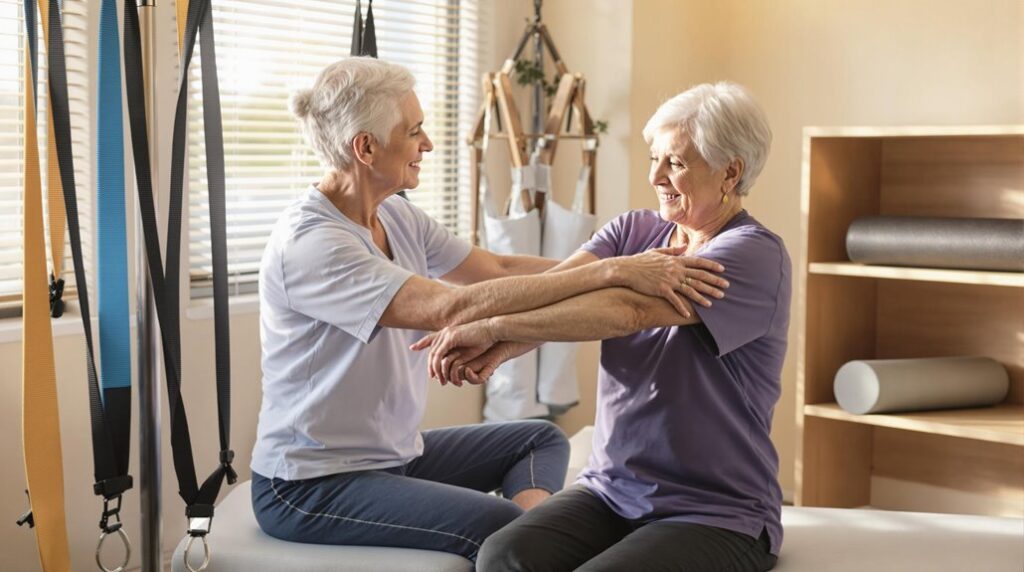To enhance joint mobility through therapy, you'll want to focus on five key techniques. Start with dynamic joint mobilizations using controlled, rhythmic movements at 30% range. Incorporate therapeutic stretching, holding positions for 15-30 seconds without bouncing. Use soft tissue release methods with foam rollers or massage tools for muscle tension. Practice self-massage on specific areas for 1-2 minutes. Finally, implement progressive movement patterns, starting with controlled articular rotations. These foundational steps open the door to advanced mobility techniques.
Dynamic Joint Mobilization Techniques
Freedom of movement lies at the heart of dynamic joint mobilization, a series of controlled exercises designed to enhance joint flexibility and function. You'll need to perform these techniques through a specific range of motion while maintaining precise control of speed and direction.
When you're executing dynamic mobilizations, you should focus on smooth, rhythmic movements that gradually increase in amplitude. Start with gentle oscillations at 30% of your full range, then progress to larger movements as your joints warm up. You can apply these techniques to major joints like shoulders, hips, and knees, moving them in multiple planes while respecting anatomical limitations. Remember to coordinate your breathing with each movement, exhaling during the most challenging phase to optimize muscle relaxation and joint mobility. Additionally, incorporating soft tissue therapy can further enhance the effectiveness of these mobilization techniques by addressing underlying muscle tension.
Therapeutic Stretching for Joint Range
While dynamic mobilization focuses on movement patterns, therapeutic stretching targets specific joint structures through sustained positions that promote tissue elongation and enhanced range of motion. You'll need to hold each stretch for 15-30 seconds, allowing time for your body's stretch reflex to subside and the tissue to lengthen effectively.
When you're performing therapeutic stretches, it's essential to work within your pain-free range and avoid bouncing movements that could trigger protective muscle responses. You can enhance your results by incorporating PNF (proprioceptive neuromuscular facilitation) techniques, where you'll alternate between gentle contraction and relaxation phases. For best benefits, you should maintain proper alignment throughout each stretch and focus on breathing deeply to help release tension in the targeted areas. Additionally, understanding muscle tear recovery times can aid in tailoring your stretching routine to better support joint mobility.
Soft Tissue Release Methods
Because soft tissue restrictions can greatly impact joint mobility, manual release techniques offer effective solutions for addressing muscular tension and fascial adhesions. You'll find that these methods target specific areas of tightness while promoting increased blood flow and tissue elasticity.
- Self-myofascial release using foam rollers or massage balls to break up adhesions and trigger points
- Pin-and-stretch technique where you'll apply pressure to a tight spot while moving the joint through its range
- Cross-fiber friction massage across muscle fibers to release stubborn knots and scar tissue
- Instrument-assisted soft tissue mobilization using specialized tools to target deep fascial restrictions
When you're performing these techniques, it's essential to work within your pain tolerance and maintain consistent pressure. You can apply these methods daily, focusing on problem areas that affect your joint mobility most notably. Additionally, incorporating sports massage can further enhance your recovery and performance by addressing specific athletic needs.
Self-Massage and Recovery Tools
Incorporating the right self-massage tools can greatly enhance your soft tissue work and recovery routine. You'll find foam rollers particularly effective for larger muscle groups, while lacrosse balls can target specific trigger points in hard-to-reach areas. For deeper tissue work, consider using a massage gun, which delivers concentrated percussion therapy to reduce muscle tension and improve blood flow.
To maximize your recovery tools' effectiveness, you'll want to spend 1-2 minutes on each target area, focusing on spots that feel particularly tight or tender. Don't forget to include mobility tools like resistance bands and massage sticks, which can help you maintain proper tissue quality between workout sessions. Remember to clean your tools regularly and replace them when they show signs of wear to guarantee peak performance. Additionally, integrating effective tools for maximizing movement can further enhance your recovery and performance outcomes.
Progressive Movement Patterns
To develop ideal joint mobility, you'll need to follow a systematic approach of progressive movement patterns that build upon fundamental mechanics. These patterns should gradually increase in complexity and range, allowing your joints to adapt safely while enhancing their functional capacity.
- Start with controlled articular rotations (CARs) to establish baseline joint control
- Progress to multi-planar movements that combine different angles and directions
- Incorporate loaded mobility exercises to build strength through expanded ranges
- Add dynamic movements that challenge stability and control in various positions
As you advance through these patterns, you'll notice improved coordination and freedom of movement. It's crucial to master each progression before moving to more challenging variations, ensuring your joints develop both mobility and stability simultaneously.

